Grinding to a halt
Anna Nazarova
Elizaveta Kazachkova
Maxim Fedosov, Managing Director, United Business Aviation Association (UBAA)
The Russian business aviation industry was growing extensively in the past five years, starting to manifest features of a civilized market. The reduction in import duties on several business jet classes and the long-awaited passage of a law permitting registration of ownership rights to aircraft, have formed a solid foundation for the sector’s future development. However, the current global financial crisis is threatening to turn the unprecedented growth of Russian business aviation into a no less dramatic slump.
Despite a number of legislative problems that have been haunting Russian business aviation for years, the demand for business jet services has remained stable, serving a reliable indicator of the general state of the country’s economy. Russia’s dynamic economic growth and lavish revenues from the oil-and-gas, banking and construction sectors were driving up the demand for business jet travel, which was expected to keep growing for another year or two before eventually leveling out. Indeed, the sector was still going strong in the first months of the global economic crisis. But then the bad news caught up with the industry. By late 2008, the growth rate of bizav traffic had plummeted from 40% earlier that year to zero. In November and December, 25% fewer bizav flights were flown in Russian airspace year-on-year; operators started reducing prices and offering discounts from 25%. Sergey Koltovich, a representative of the Austrian business aviation operator Jet Alliance, believes that Russian carriers started 2009 in the red, often selling flights at a loss due to the shrunken demand. According to Russia’s United Business Aviation Association (UBAA), by February 2009 the domestic bizav market had rolled back to the 2006 positions.
Business jets down on their luck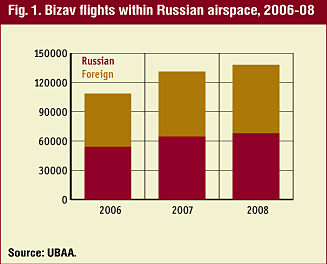
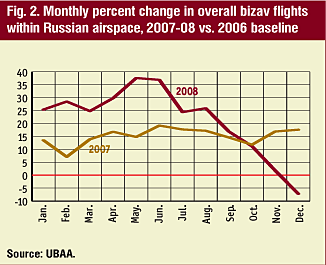
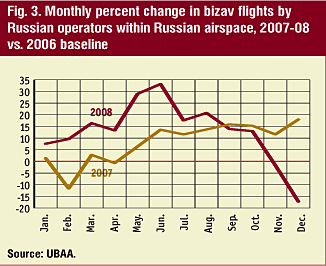
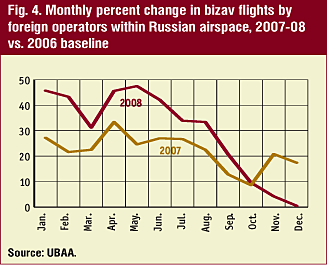
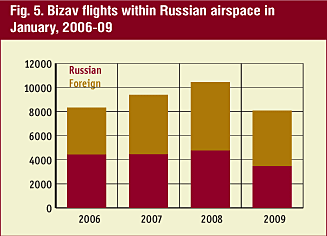
Business jets have been historically viewed as more of a status symbol in Russia than a business tool. The downturn-induced ethos of cost control is putting an end to this, with the market focus shifting to second-hand airframes. According to Artem Pastukhov from Jet Trading Group, up to one-third of all business aircraft owned or operated by Russian nationals have by now been put up for sale. Another 30% owners say they may sell if offered the right price. Koltovich seconds this estimate, saying that 100 to 150 out of the overall 300-400 business aircraft previously bought or ordered by Russian nationals have been put up for sale in 2009.
The problem is, there are no buyers - not a single business jet sale has been reported in Russia since October 2008, despite the prices having dropped 10-20% on the summer 2008 level (and sometimes to as low as 50% of the 2008 value). Jet Trading Group expects the gap between the supply and demand to persist until 2011, saying that no recovery should be expected before 2014.
Going down in flames
According to the UBAA, both national and foreign bizav operators enjoyed an increase in traffic in 2006-2008 (see Fig. 1). Overall growth in corporate flights during that period amounted to 21.6%; the figure was 15.1% for Russian operators and 28.6% for foreign operators. The UBAA bases its conclusions on an analysis of all unscheduled flights in Russian airspace, the critical assumption being that all such flights are by definition related to business aviation operations.
A month-by-month comparison to the 2006 baseline data (see Fig. 2) points to October 2008 as the watershed between the rapid growth of the fat years and the onset of recession. The crisis hit full-force in December, when the number of flights dropped below the 2006 levels.
The number of flights by Russian operators peaked in June 2008, then took a plunge in August and never really recovered afterwards (see Fig. 3). Foreign bizav operators recorded a significant growth in flights during the first nine months of 2008 (see Fig. 4). However, in October their performance dropped to the 2007 level, and December saw it dive even lower — past the 2006 point of reference.
The drop in demand for corporate air travel hit Russian operators harder than their foreign competition, chiefly because of their scarce numbers and limited range of available destinations. Most domestic bizav carriers operate corporate jets that have been converted from Soviet-time airliner types. These aircraft are no longer allowed to fly to Europe for failure to meet international noise and emission standards, and foreign customers are loath to travel by them. These operators’ market is therefore limited to Russia and the CIS. In crisis, this is clearly a disadvantage.
An analysis of January bizav operations (see Fig. 5) indicates that the total number of flights performed in the first month of the year dropped 2.3% this year against the same month in 2006. The number of foreign-operated flights, although down on 2008, still exceeded the 2006 level by 18.8%. Russian-operated flights were 27.8% down on January 2006.
For the time being, Russia’s bizav market is still holding out — largely thanks to the performance of foreign operators. Experts warn that traffic may slump even further this year, contributing to an overall 20-30% drop on 2008.
The long-awaited passage of a law permitting state registration of personal ownership rights to aircraft raises mixed feelings. On the one hand, it must have a positive effect on business aviation, because potential owners will now find it easier to attract investors. The law, passed in March 2009, will make it possible for Russian banks to view registered fixed-wing aircraft and helicopters as pawnable assets. On the other hand, given the global nature of the economic crisis, it is becoming more and more difficult to secure financing of aircraft purchasing deals. Russian traditional practices of doing things also demonstrate that the passage of some laws raises more questions than it provides answers. Time will tell how objective these appraisals are. Meanwhile, the positive changes in the regulatory framework and the lowering of import duties on some business aircraft classes have created a solid foundation that will start working as soon as the global economy begins to recover, driving up the energy prices – the key factor influencing the demand for business aviation travel in Russia.
Ссылки по теме
- Для того, чтобы оставить комментарий, не привязанный к социальной сети, войдите или зарегистрируйтесь на нашем сайте.
АТО-телеграф
CIS & Russian Aviation News And Insights
- Russian airlines’ traffic drops two per cent so far in 2025
- Ural Airlines’ operational performance affected by A320neo groundings
- Volga-Dnepr Group founder warns the company may be nationalized
- Aeroflot revenue grew 10 per cent during first half of the year
- Russian airlines’ January through July traffic and RPKs decline
- Aeroflot Bonus members can now access the full range of services
- A manufacturing defect has been discovered in Superjet 100 aircraft









